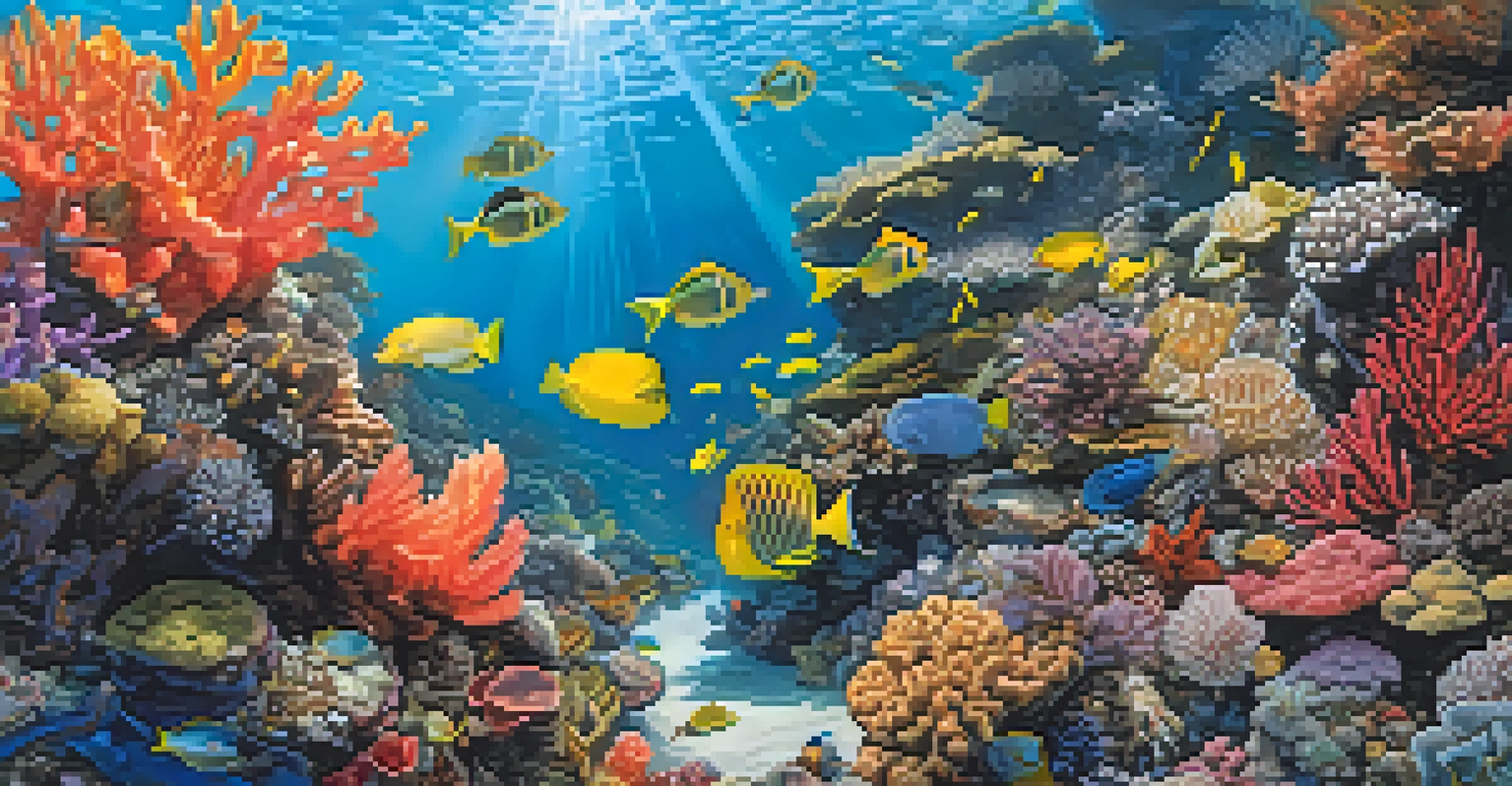Impact of Climate Change on Tampa's Coastal Ecosystems

Understanding Tampa's Coastal Ecosystems
Tampa's coastal ecosystems are vibrant and diverse, featuring mangroves, seagrasses, and coral reefs. These habitats not only provide essential services like water filtration and shoreline protection but also support a variety of wildlife. The delicate balance of these ecosystems makes them particularly vulnerable to environmental changes. By understanding their complexities, we can better appreciate their importance to both nature and human communities.
We won't have a society if we destroy the environment.
The Tampa Bay estuary is a prime example of a coastal ecosystem that thrives on the interaction between freshwater from rivers and saltwater from the Gulf of Mexico. This blending creates a unique habitat that nurtures fish, birds, and various other species. However, changes in temperature and salinity due to climate change can disrupt these interactions, leading to significant consequences for the local flora and fauna.
Additionally, coastal ecosystems play a crucial role in mitigating climate impacts by acting as carbon sinks. Mangroves, for instance, can sequester large amounts of carbon dioxide, helping to alleviate some effects of climate change. Protecting and restoring these ecosystems is vital not just for biodiversity but also for combating climate change itself.
Rising Sea Levels Threaten Coastal Areas
One of the most pressing issues resulting from climate change is rising sea levels, which pose a significant threat to Tampa's coastal areas. As polar ice melts and ocean waters expand due to warming, low-lying regions face increased flooding and erosion. This not only endangers natural habitats but also puts human infrastructure at risk.

In Tampa, neighborhoods close to the coast are already experiencing more frequent flooding during high tides and storms. This phenomenon, known as 'sunny day flooding,' serves as a stark reminder of the challenges ahead. Communities must adapt to these changes, which may involve investing in resilient infrastructure and restoring natural buffers like wetlands.
Tampa's Ecosystems Are Vulnerable
Coastal ecosystems in Tampa, including mangroves and coral reefs, are essential for wildlife and human communities but are threatened by climate change and rising sea levels.
Moreover, rising sea levels can lead to saltwater intrusion, where saltwater contaminates freshwater sources. This can have dire consequences for local agriculture and drinking water supplies. To mitigate these risks, proactive measures and community engagement are essential.
Impact of Increased Storm Intensity
Climate change is also linked to the increased intensity of storms, which can have devastating effects on Tampa's coastal ecosystems. Warmer ocean waters fuel more powerful hurricanes and tropical storms, leading to stronger winds and higher rainfall. This can result in severe flooding, habitat destruction, and loss of biodiversity.
The greatest threat to our planet is the belief that someone else will save it.
For instance, when a hurricane strikes, the powerful storm surge can wash away vital coastal habitats like mangroves and seagrass beds. These ecosystems are crucial for fish breeding and provide shelter for many marine species. The loss of these habitats can create a ripple effect, impacting the entire food chain.
Additionally, the aftermath of storms often leaves behind debris and pollutants that can further harm these delicate ecosystems. It’s crucial for local governments and communities to have disaster preparedness plans that prioritize the protection and restoration of coastal habitats.
Effects of Ocean Acidification on Marine Life
As carbon dioxide levels rise in the atmosphere, much of it gets absorbed by the oceans, leading to a phenomenon known as ocean acidification. This alteration in ocean chemistry can severely impact marine life, particularly organisms like corals and shellfish that rely on calcium carbonate to build their shells and skeletons. In Tampa, this can threaten both biodiversity and local fisheries.
Coral reefs, often called the 'rainforests of the sea,' are especially vulnerable. They not only provide habitat for countless marine species but also support local economies through tourism and fishing. If these reefs continue to decline due to acidification, the consequences could be dire for both marine biodiversity and the human communities that depend on them.
Rising Sea Levels Impact Communities
Increased flooding and saltwater intrusion due to rising sea levels pose significant risks to Tampa's coastal areas, affecting both natural habitats and local infrastructure.
Furthermore, ocean acidification can disrupt the entire marine food web. As key species struggle to survive, the effects can cascade throughout the ecosystem, leading to population declines and altered species interactions. Understanding and addressing this issue is crucial for the health of Tampa's coastal waters.
Threats to Biodiversity in Coastal Ecosystems
Biodiversity in Tampa's coastal ecosystems is under threat from climate change, habitat loss, and pollution. Many species that rely on specific environmental conditions may struggle to adapt to rapid changes, leading to declines or even extinction. This loss of biodiversity can weaken ecosystem resilience, making them more susceptible to future environmental stresses.
For example, species like the manatee and various fish populations rely on healthy seagrass beds and mangroves for feeding and breeding. As these habitats deteriorate, so too do the populations that depend on them. This can lead to a decrease in fish catch for local fishermen and a loss of recreational opportunities for residents and tourists alike.
Conservation efforts aimed at protecting and restoring habitats are crucial not only for the species at risk but also for maintaining the overall health of the ecosystem. By fostering biodiversity, we can enhance the resilience of coastal ecosystems, allowing them to better withstand the impacts of climate change.
Community Engagement and Action Plans
Addressing the impact of climate change on Tampa's coastal ecosystems requires strong community engagement and action plans. Local residents and stakeholders play a crucial role in conservation efforts, and grassroots initiatives can drive meaningful change. By raising awareness and fostering collaboration, communities can work together to protect these vital ecosystems.
Educational programs can empower individuals to take action, whether it's participating in beach clean-ups, advocating for policy changes, or supporting local conservation organizations. Engaging the community helps build a sense of stewardship and responsibility toward the environment, ensuring that everyone plays a part in its preservation.
Community Action Is Crucial
Strong community engagement and comprehensive action plans are vital for protecting and restoring Tampa's coastal ecosystems amidst the challenges posed by climate change.
Moreover, local governments can develop comprehensive climate action plans that prioritize ecosystem protection and restoration. These plans can include measures like habitat restoration projects, sustainable land use policies, and community resilience strategies. When communities unite for a common cause, they can make a significant impact on the future health of Tampa's coastal ecosystems.
The Path Forward: Sustainable Solutions
Finding sustainable solutions to combat the impacts of climate change on Tampa's coastal ecosystems is essential for a resilient future. This involves a multifaceted approach, including habitat restoration, sustainable fishing practices, and reducing pollution. By integrating ecological science with community action, we can develop strategies that benefit both the environment and local communities.
For instance, restoring mangrove forests not only aids in carbon sequestration but also provides critical habitat for numerous marine species. Similarly, implementing sustainable fishing practices can help protect fish populations and ensure their viability for future generations. These actions contribute to the overall health of the ecosystem, creating a more sustainable environment.

Lastly, collaboration among government agencies, non-profits, and local communities is key to developing effective solutions. By sharing knowledge and resources, stakeholders can create innovative strategies that address the unique challenges posed by climate change. Together, we can pave the way for a healthier and more sustainable coastal ecosystem in Tampa.